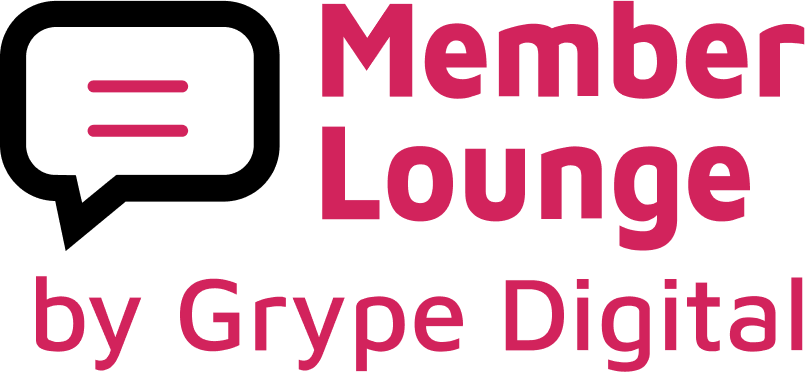Membership Site Revolution
Making the decision to build a new membership site for your association is a big one! It is usually a sign that your current member portal is not meeting the needs of your membership. Creating a membership site that will create an engaging, easy-to-use, and easy-to-navigate user experience where members can easily access their member benefits is a complex process. It’s important to listen to your members, your team, your stakeholders, and trusted membership site UX specialists.
This blog is about listening to all those voices throughout your development and launch process to ensure smooth and successful results in creating a membership site that works. The process of listening to all those voices and creating a membership site that members will use is called Change Management. This blog is about using change management best practices throughout the development process.
We’ll talk about the various processes of development and who to include in the design, development, testing, and launch plan for each stage.
Change Management & Your Membership Site
It is important to incorporate change management best practices into your process when creating a membership site. users — your members and your internal staff — accept and engage with your new membership site. It sure would be disappointing if you built and launched a site that your members don’t want to use. Let’s make sure that doesn’t happen!
This blog will help you understand how associations can use change management principles to help navigate a membership site project. The suggestions and strategies shared here have been culled from our podcast interview with Change Management Consultant and Educator, Betsy Bond. To learn more, watch our podcast episode ‘Successful Membership Site Transition: Ensuring Buy-In from Your Team and Membership‘.
What Is Change Management?
Change management involves preparing people for an upcoming change. It’s not about technology choices or training. It involves all the people who will be part of the change, including the members, the staff, and the senior management.
The change management process in a nutshell: Think about how and what your members want, and how members want to interact. Ask your members! They will tell you. Give them the information they need when they want to receive it in the method they want.
Understanding Change Management
Change management is complementary to project management. It helps ensure that users — namely your members — accept and embrace the new tools you create for them.
Project management is about delivering a solution. The project managers work out the schedule, and the budget and manage risks through the process of making the solution. But they usually take off on launch.
Change management, on the other hand, focuses on how to get members to use the solution (or tool) your association has provided for them. The solution can be the most beautiful, advanced tool, but when members reject it, no one wins.
It’s easy to produce the product in a vacuum. The challenge is to introduce a change that people will accept.
The 3 Stages Of Change Management
The Solution Brainstorming Stage
This is the first step of change management in creating a membership site. We need to explore if your members will want the solution your association has in mind. Start with exploring members’ willingness for a change.
Consult stakeholders and get to know how the change impacts them. Also ask members what their problems are, and what their goals are, and brainstorm solutions together.
This isn’t just a lip-service exercise to “make members feel included”. It is good business to make sure you clearly understand the problems before investing in a solution. (A good developer will not take on a project or even offer a quote without a detailed understanding of the goals of a project, and an association shouldn’t move forward without this research either.)
The Design Stage
Too often, though, the decision to pursue a specific solution has already been made and the strategy has been decided before members are consulted. When the decision has already been made, change management comes in at this time: namely, the design process.
The Ninth Hour Stage
The sad reality is that many organizations wait until the final hour. This creates a mad rush to prepare all parties for the change. In that rush, things are missed.
In terms of when it ends, you should expect the change management team to stick around a lot longer than the project management team. Change management continues until the change has been integrated into your association’s culture. Once the project has been delivered, the change management team commonly faces the task of heavy lifting. They must ensure the integration of the new tool into regular use by members. Change management persists until your association’s culture has absorbed the change.
Surveys, Talks, and Feedback Collection
The membership team, the marketing team, and the financial team all play an important role when it comes to creating a membership site. Each team has its own unique responsibilities, viewpoints, and contributions to make to the conversation. You would start with a stakeholder analysis and involve everyone who will be affected by the change. Go beyond the technology in this analysis stage.
When done well, it takes into account the people over the tech: what are their attitudes to overcome, skills that need to be developed, will relationships be impacted, etc. Usually, the how-tos for the tech (i.e. the processes and procedures) are easier than changes to relationships and winning over attitudes.
Speak to everyone. Hearing your stakeholders express themselves will allow you to ask follow-up questions and identify what are the actual problems you are trying to solve.
Look at each unique group in detail and consider the technical aspects, processes, and the people impacted. The best way to do this is to talk to them. Have a conversation designed as a workshop. Members generally know what they need, so ask them! You’ll get some incredibly deep insights.
You don’t need to bring in everyone. Representatives from each level that understand their department is sufficient. Ask them how they want to be supported, how they want to receive information, how they want to be trained, how they want access to updates and quick references, and what they need from the leadership.
With this information, your focus changes from the information-gathering stage to how to resolve the issues that will come up for your members and the people involved.
A Day-In-The-Life-Of Interviews
These interviews are useful for documenting processes, but the blindspot of the day-in-the-life-of exploration is it doesn’t give a full picture of the interactions between different people. For example, what happens when an association staff member interacts with their superior, their subordinate, their coworker, or a member?
Take as an example moving to a new location, or the membership site crashing, or an annual important fundraiser or association conference. A day-in-the-life interview doesn’t address changes outside of that myopic view of the activities of a typical day.
Understand What Your Members Want
Early days are not the time to bring everyone on board because we aren’t sure of the direction your association will go in. You have to be selective about who you start early with. Start with a group of members that will be honest with you and tell you what your users are going to like, want, not want, be excited about, and be concerned about.
There are chances of missing key things with a limited number of people who are part of the early conversation. Yes, absolutely, things will be missed. But design by committee doesn’t work either. Do your best to pick informed, key people and continue with an iterative process, inviting more members as you go. As you get closer and closer to training and launch, bring more and more members in.
Development Team Role
We are creatures of habit. Even throughout the process of envisioning change, we can unconsciously start creating a solution that is very similar to the tools we currently use. It is best to have some experienced strategists and developers involved in the design process.
Make sure your developers can offer experience and strategy rather than just carrying out a prescribed vision. Your developers should be empowered to question your assumptions and offer practical advice. This is important in creating a membership site that wows.
Incorporate Feedback Into Design
Agile design is a collaborative interactive approach to web design that lends itself perfectly to change management. It is important especially if you are creating a membership site that will be amazing.
Agile design is based on the idea that team members work together rather than in silos. Work is built in phases and work — even partially completed work — is demoed often for review. Every time you get to a release, you have to demo the delivered features to the member community to get feedback in a structured way.
Do not fall prey to the mindset that you are in a rush and there isn’t time for this. It will be much worse to launch a completed product that is not well received by the member community. Build this demo and feedback collection process into your web development timeline to make sure the product being built is on track.
Circle back to consult with your stakeholders regularly throughout the development process. Demo any features that have been created. Getting their feedback on each piece of development will help inform and improve each subsequent phase of development. This will help troubleshoot issues your users and members will have with the product before your formal launch.
This is the nature of work: we are short of time. Plan and schedule for exploration and feedback. Avoid making last-minute demands and last-minute meetings. Be realistic about the time it will take.
Overcome Resistance To Change
It is a common idea that people don’t like change. People are not really resistant to change. Rather, they are addicted to comfort. By including your members in the development process they become familiar with the tool before it is even launched. Make the most time to get feedback from members who will find the change the most uncomfortable. You will learn the most from the people who are most resistant. Their involvement creates the familiarity and confidence to successfully use and embrace the new membership site.
Presumably, your association is introducing a new membership site because a new membership platform is needed. Your association is likely not making this change on a creative whim. You likely did your research on different membership sites on the market.
Big advice: don’t pick a tool on any other metrics other than your data. Use your member engagement data to make your decisions around changes. What are you hearing from your members? What are you hearing from your staff? Are your member retention and member engagement rates slipping because the membership site you currently have isn’t serving them? From this standpoint, you are only making a change that will appease your members’ hunger for an improved user experience.
Listen To Your Members
One of the best ways to figure out what is driving the resistance is a conversation. Make the time to hear them and give them a voice. More often than not, we make assumptions and we stand to learn a lot about how to launch a product that is a real solution by listening to them.
The second tactic is to make them as familiar with the product as possible. Get them involved, give them a task, and ask them to review features along the way. This way, on go-live day, they are familiar with it.
Recruit Members For Feedback
It’s much harder for your association to get the attention of your members than your employees. Employees have to participate, but for members, their time and membership are discretionary.
When reaching out to recruit members to participate in the change management process, some members express keen interest in contributing, while others demonstrate reticence or disinterest. Involve expert communicators who can help reach as many members as possible. Make the communications far more focused on the member than the solution. Focus on the benefit to the member, not the perks of the new tool.
When communicating with members about the new membership site, make it clear what type of information you are sharing and for what goal. Is this communication sharing information for keeners who want all the details, or truly an important update with required action items for the members?
For example, “We need members to log in just once to confirm your password” versus “Here is a detailed update of what we have been up to behind the scenes.” Not all members want to get lost in that second option and will be turned off and miss the first one if they don’t know what to expect.
Also recognize that when your association has information to communicate to members, it doesn’t mean the members are ready to listen. Member-based associations are on a timeline, but most of our members are not on our timeline. With this in mind, associations cannot expect blasts of information to suffice. The communications around using the solution have to be easy to access when the member is ready to receive it.
Challenges With Change Management
When a beautiful membership site or feature is created without considering the end user and use case, user acceptance problems occur. The smartest, most well-intentioned people can build it, but without truly understanding your client persona and obtaining feedback on feature demos throughout an interactive process, you create a tool that your members don’t want to use because it doesn’t solve their problems.
Onboarding Members To The New Membership Site
Adoption of the new membership site is not about the tech, it’s about the people. Getting members involved is key. Getting members to take the time to share their opinions is harder since you are not an employer requiring an employee to participate. Have focus groups and demos that are organized and focused and respect your members’ time. If the member doesn’t feel it’s a good use of time, they won’t come back for the second round of demos.
It goes without saying that the feature should be easy to use. It goes without saying that your association has tested the feature and it’s obvious to members how to engage and benefit from it.
Include instructions and help text as needed. A good practice is to have a way for the user to get on-demand help. Have a button or icon members can click on for more help.
Feedback, Feedback, Feedback, Launch, Then More Feedback
Include your members and staff in the process of testing each feature. This will help your association. You get to will end up with a product that will be accepted and embraced by them.
The best way to bring everyone on board with a solution that best serves the members is to have a conversation and give everyone a voice. Allow the people who are responsible for the website to express their concerns. This might include the marketing department and their reservations regarding the changes that the membership managers want. Allow them to hear how the membership team is expressing the needs and wants of the membership. Let the conversation guide your association.
Learn How To Improve Your Membership Site
You don’t have to fumble through a membership site transition alone. Register for an upcoming webinar or live podcast





